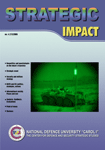THE RELATION BETWEEN SUPRASTATE AND EMPIRE, IN THE EUROPEAN UNION CASE
THE RELATION BETWEEN SUPRASTATE AND EMPIRE, IN THE EUROPEAN UNION CASE
Author(s): Mădălina Virginia AntonescuSubject(s): Government/Political systems, EU-Accession / EU-DEvelopment, EU-Legislation
Published by: Carol I National Defence University Publishing House
Keywords: Superstate; Empire; EU;
Summary/Abstract: The article is recommending exploring a triple political relation that can be established between three distinct political concepts: empire, suprastate and the political system of European Union. The European supranational tendency has accompanied the European construction still from its beginnings, marking both institutional successes – as, for example, the creation of the High Authority within the European Community of Charcoal and Steel system/1952, an institution with clear supranational competences mentioned in the Paris treaty, and then transformed into the European Commission – equally, this institution being perceived as a genuine supranational executive; or the creation of the European Central Bank -, as failures, as well: for example, the Defence European Community failure, due to the French Senate refusal to ratify, in 1954, the treaty. The European supranational tendency is not only present on the institutional stage ( because it is thought that all political institutions entrusted, through the juridical compulsory effect of the European treaties, to the new created political system - the European Union, have all a clear supranational character), but it is also present in other elements contributing to the evolution of the European process of integration: the European citizenship, the unique market; the legal order of the European Union; the juridical characters of the European law: direct effect; direct applicability; pre-eminence in relation with national law. In the European Constitution draft, the D’Estaing variant, the supranational elements are not mentioned as such, but they are implicitly arising from the political nature of the European institutions and from their specific functions: the creation of the Unional Ministry of Foreign Affairs; a progressive increase of the exclusive competences of the EU; the EU aptitude to have express legal personality. These are proving a clear maintenance and even the evolution of the European supranational is, despite the failure moments or the crisis happened during the European construction. Secondly, the European supranationalism has recorded equally, a certain progress, because new supranational elements have been added to the already existent supranational elements; in fact, it can be said that supranationality was a constant contribution to the European construction, which was be balanced by the states and limited though developments of so-called “intergovernmental” elements, pledging for a pre-eminent role of the states within the EU system and implicitly, for limitation of EU powers in sensible sectors. On the other hand, related to imperial idea, it must be noticed that empire is a profoundly flexible political concept, history recording different types of empires like those starting from a tribe, a clan, until the more elaborated empires- federation, empires based on a great state, confederations of cities or suprastate. Insomuch as the supranational elements are recognized as belonging to the Union, this political entity can be considered as a new type of postmodern empire, differing from others types of historical empires ; in this respect, EU can become a type of empire based on a specific European suprastate. But this is quite a limited vision, risking to neglect other elements specific to the federation, to the state, to the international intergovernmental organizations, to the confederation, that are characteristic to EU, but also, risking to neglect other original elements from this hybrid structure, that are equally contributing to the imperial idea about the European Union.
Journal: Strategic Impact
- Issue Year: 2005
- Issue No: 17
- Page Range: 27-35
- Page Count: 9
- Language: English

